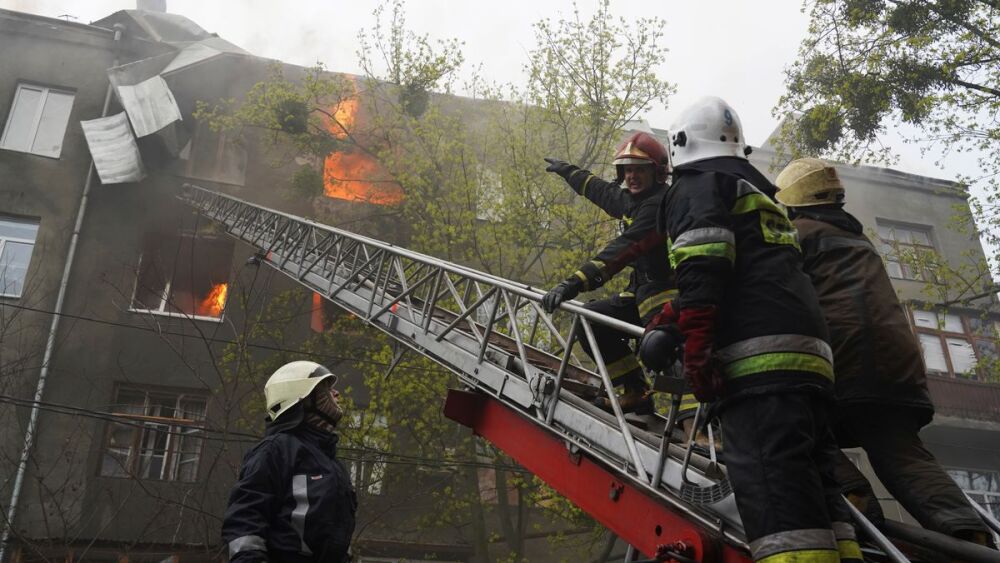The dedication of Ukrainian firefighters has been shown to us nearly every day since the Feb. 24 invasion began by Russian troops into their country. Since that time, an estimated 100,000 Ukrainian civilians have been killed, with an estimated 200,000-plus injured.
As points of reference, Ukraine has a population of approximately 43 million people with 233,000 square miles of territory. That makes it slightly smaller than Texas in area and slightly more than California in population.
While the Ukrainian Embassy in Washington, DC, has not provided an estimate of the number of firefighters and aid workers currently working in their country, and an estimate of how many of those have lost their lives thus far this year during the conflict, it appears, based on various media reports, that at least 43 firefighters have been killed in the first months of this war. As this war in large part has included the destruction of cities, towns and even refugee areas, the number of firefighter deaths has most certainly grown exponentially.
The images of these firefighters facing near-daily barrages of battle continues 10 months into the war. Finding it difficult to hold onto their land gains, the Russians most recently have reverted to locations where they can regroup, re-arm and resupply their troops in or near Ukraine.
As winter sets in, several military analysts believe Ukrainians will continue to press their advance. However, they also believe that the Russians will return to their most basic and most familiar tactic of warfare – using artillery barrages, as well as concentrated short-range missile and drone strikes.
The primary targets of these weapons will have been within population centers, where energy facilities, electric power plants and warehouses are lucrative targets, hoping that the lack of these necessities will break Ukrainians’ resolve to continue their fight.
The result of these attacks are continuous fires that have to be contained by firefighters while also doing their best to render aid to the mounting civilian injuries. For example, on Nov. 15, eight cities across Ukraine were simultaneously struck by a coordinated missile attack. Ukrainian defenses shot down more than 50 of these air strikes, but all eight cities suffered severe damage to their critical infrastructure and, in some cases, similar damage to residential areas.
In these attacks, two missiles struck the Polish border town of Przewodow. The follow-on investigation confirmed that these were part of Ukrainian anti-missile defense, trying to knock down the Russian missiles aimed at Ukrainian border cities. While this was a mistake, it was also a wake-up to the NATO nations, especially those in Europe. This war that all parties had tried to contain to Ukraine could now easily escalate to other countries of the NATO alliance.
That incident, however, hasn’t deterred the Russian forces from their strategy of using artillery and missiles against populated targets. On Nov. 24, a barrage of Russian missiles aimed into the capital of Kiev, knocked out nearly 90% of the electric grid and water system, leaving its citizens and its firefighters without water in most areas of the city.
Prior to those November strikes, most all of us had put Ukraine at least briefly out of our minds, as we concentrated on domestic issues, including the mid-term elections. But these most recent attacks quickly reminded us of the efforts of Ukrainian firefighters as they were again shown in the media fighting major fires in an apartment complex and searching for trapped victims during the attack.
Ukrainian firefighters are also battling several other issues. As the attacks continue on the infrastructure of each city, which includes most of their water supply systems, I am amazed at the volume of water they can summon to extinguish these fires. While we see several water tenders in some of the photos, I can’t imagine the scale of those efforts when it involves row after row of occupied and/or abandoned buildings.
Once again, my thoughts revert to the days of “the Blitz” in London in the early 1940s. Few of us realize that the large-diameter hose and Stortz couplings we use today are a direct result of studies done by post-war firefighters in the United States.
Those serving overseas in World War II watched the London Fire Brigade lay large above-ground metal water mains where the enemy attacks had destroyed their underground water mains. They also saw that several European countries, including Germany, had developed the more universal Stortz-like coupling for quicker firefighting operations.
Perhaps we will learn more lessons from our Ukrainian counterparts in the coming years that will benefit our future tactics and preparedness.
Whatever may take place in the coming new year, I would like to propose that 2022 be recognized by all of us in the fire service as the “Year of the Ukrainian Firefighter” for their courage, fortitude and resilience in the face of these unspeakable odds.
Stay safe!















